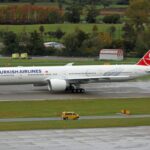Injuries experienced during turbulence over the Bay of Bengal were treated on a number of passengers.
On Wednesday night, strong clear air turbulence forced a Qatar Airways flight headed for Bali to detour to Bangkok, injuring some of the passengers.
incident specifics
Following a significant wave of turbulence while flying through 37,000 feet over the Bay of Bengal on May 10, Qatar Airways flight QR960 between Doha (DIA) and Denpasar (DPS) was forced to divert to Bangkok (BKK), injuring numerous passengers.
Less than six hours after takeoff and around 30 minutes after the incident, the airplane landed in Bangkok at around 18:00 ICT, giving passengers and crew time to seek medical attention.

The Boeing 777-300ER (A7-BAN), which is 12 years old, has not been reported to have any damage. Before flying to Denpasar on Thursday afternoon, the plane spent Wednesday night at Bangkok Airport. The airline claims that during the unplanned layover in Thailand, all passengers received meals and lodging.
After an almost four-hour trip between the two cities, the subsequent flight, known as QTR960D, eventually touched down in Denpasar at 21:41 WITA.
Qatar Airways verified the event and provided some additional details in a statement that was posted on Twitter.
After encountering clear air turbulence that caused some moderate and a few mild injuries on board, Qatar Airways flight QR960 from Doha to Denpasar diverted to Bangkok. “Medical teams were waiting for the aircraft when it safely landed to assist those who needed it,” the Doha-based airline tweeted.
“Tomorrow (May 11), Qatar Airways will continue the trip to Denpasar by providing all passengers with meals and overnight accommodations in Bangkok. We apologize for any trouble this has given our customers. Our first focus is still the safety and security of the crew and passengers.
comparable events
Due to its tumultuous and occasionally unpredictable weather patterns, the Bay of Bengal, which separates India and Southeast Asia, is known for leaving travelers green in the face.
When a Malaysia Airlines Airbus A380 (9M-MNF) flying between London Heathrow (LHR) and Kuala Lumpur (KUL) encountered extreme turbulence over the area in June 2016, 40 passengers suffered injuries serious enough to require medical attention when they arrived in Malaysia. 34 passengers and six crew members were hurt when the MH-1 flight, which was being operated, was rattled by winds crossing the Bay of Bengal.
No other problems were encountered and the crew of MH-1 flew on to Kuala Lumpur.In July 2019, while traveling between Auckland (AKL) and Dubai (DBX), another A380, this one flying for Emirates, was likewise buffeted by turbulence around Chennai. 13 passengers and 13 crew members sought medical attention for minor injuries, while at least one person was treated for serious injuries upon arrival in Dubai. The medical professionals at the airport transported an unidentified person to the hospital.
According to the UAE GCAA’s final assessment, a storm cell passing over the area caused extreme air turbulence that led to the accident. The GCAA recommended that the cabin crew continue to communicate in advance and remind customers to fasten their seat belts during turbulence and flying.




